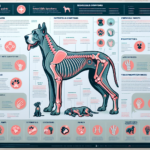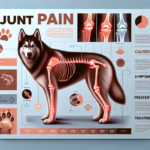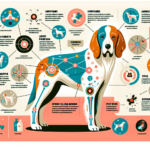Karelian Bear Dog Joint Pain: Causes, Symptoms, Prevention, and Treatment

Introduction
The Karelian Bear Dog is a breed known for its courage, agility, and hunting prowess. Originating from the Karelia region between Finland and Russia, this breed has a rich history of being used for hunting large game, including bears, moose, and wild boar. Characterized by its black and white coat, pointed ears, and muscular build, the Karelian Bear Dog is not only a skilled hunter but also a loyal and protective companion.
Like many breeds, the Karelian Bear Dog is susceptible to certain health issues, with joint pain being a significant concern. Joint health is crucial for this breed due to its active lifestyle and the physical demands placed on its body. Understanding the causes, symptoms, prevention, and treatment of joint pain in Karelian Bear Dogs is essential for ensuring their well-being and longevity.
Breed-Specific Joint Pain Risks
Genetic Predisposition
The Karelian Bear Dog, like many other breeds, has a genetic predisposition to joint-related issues. Common conditions include hip dysplasia, elbow dysplasia, and arthritis. Hip dysplasia occurs when the hip joint does not fit into the hip socket properly, leading to pain and mobility issues. Elbow dysplasia involves abnormal development of the elbow joint, causing lameness and discomfort. Arthritis, a degenerative joint disease, can also affect this breed, leading to chronic pain and stiffness.
Age-Related Risks
As Karelian Bear Dogs age, the risk of developing joint pain increases. While younger dogs may show few signs of joint issues, older dogs are more likely to experience symptoms due to the wear and tear on their joints over time. Owners should be particularly vigilant as their dogs reach middle age, typically around 5-7 years, and into their senior years.
Activity Level and Joint Stress
The Karelian Bear Dog is known for its high energy levels and active lifestyle. Whether used for hunting, working, or as a companion, this breed requires regular physical activity. However, the intense physical demands can contribute to joint stress and exacerbate existing conditions. Activities such as running, jumping, and navigating rough terrain can put additional strain on the joints, making it essential to balance exercise with joint health considerations.
Common Symptoms of Joint Pain in Karelian Bear Dogs
General Symptoms
Owners should be aware of common symptoms of joint pain in Karelian Bear Dogs, including:
- Limping or favoring one leg
- Stiffness, especially after rest or sleep
- Reluctance to move, jump, or climb stairs
- Decreased activity or playfulness
- Swelling around the joints
- Whining or showing signs of discomfort when touched
Breed-Specific Symptoms
In Karelian Bear Dogs, joint pain may manifest in specific ways due to their unique build and activity levels. Owners might notice a decrease in their dog’s hunting or working abilities, reluctance to engage in activities they once enjoyed, or changes in gait and posture. These breed-specific symptoms can be subtle but are important indicators of joint health issues.
When to Consult a Vet
If any of the above symptoms are observed, it is crucial to consult a veterinarian promptly. Early diagnosis and intervention can significantly improve the quality of life for a Karelian Bear Dog suffering from joint pain. Regular veterinary check-ups are also essential for monitoring joint health and catching potential issues early.
Preventive Measures for Joint Health
Exercise Recommendations
Maintaining an appropriate exercise routine is vital for the joint health of Karelian Bear Dogs. While they require regular physical activity, it is important to avoid overexertion. Low-impact exercises such as swimming and controlled walks can help keep their joints healthy without causing excessive strain. Owners should also provide opportunities for mental stimulation to keep their dogs engaged and happy.
Dietary Suggestions
A balanced diet rich in essential nutrients can support joint health in Karelian Bear Dogs. Foods containing glucosamine, chondroitin, and omega-3 fatty acids are particularly beneficial. These nutrients help maintain cartilage health, reduce inflammation, and support overall joint function. Owners may also consider joint supplements, but it is advisable to consult a veterinarian before adding any new supplements to the dog’s diet.
Weight Management
Maintaining a healthy weight is crucial for reducing joint stress in Karelian Bear Dogs. Excess weight can exacerbate joint issues and lead to additional health problems. Owners should monitor their dog’s weight and adjust their diet and exercise routine as needed to ensure they remain within a healthy weight range. Regular weigh-ins and body condition assessments can help keep track of their progress.
Early Screening and Monitoring
Early screening and monitoring are essential for catching joint issues before they become severe. Regular veterinary check-ups should include joint health assessments, especially as the dog ages. For breeds like the Karelian Bear Dog, specific screening tests such as hip and elbow evaluations can help identify potential problems early on. Early intervention can significantly improve outcomes and quality of life.
Treatment Options for Joint Pain
Non-Surgical Treatments
Non-surgical treatments for joint pain in Karelian Bear Dogs include medications, physical therapy, and lifestyle adjustments. Anti-inflammatory medications and pain relievers can help manage symptoms and improve mobility. Physical therapy, including exercises and stretches tailored to the dog’s needs, can strengthen muscles and support joint function. Lifestyle adjustments such as providing a comfortable resting area and avoiding high-impact activities can also alleviate joint pain.
Surgical Options
In severe cases, surgical intervention may be necessary to address joint pain in Karelian Bear Dogs. Common surgical options include hip replacement, arthroscopy, and joint fusion. These procedures can help restore function and reduce pain, but they come with risks and require a thorough evaluation by a veterinary specialist. Post-surgical care and rehabilitation are crucial for successful recovery.
Alternative Therapies
Alternative therapies such as acupuncture, hydrotherapy, and massage can provide additional relief for Karelian Bear Dogs with joint pain. Acupuncture involves the insertion of fine needles into specific points on the body to stimulate healing and reduce pain. Hydrotherapy, or water therapy, allows dogs to exercise in a low-impact environment, reducing joint stress. Massage can help improve circulation, reduce muscle tension, and promote relaxation.
Lifestyle and Management Tips
Daily Care Routine
A daily care routine for managing joint pain in Karelian Bear Dogs should include gentle exercise, a balanced diet, and regular monitoring of symptoms. Owners should provide a comfortable resting area with supportive bedding and avoid activities that may exacerbate joint pain. Consistent routines and positive reinforcement can help keep the dog active and engaged.
Modifying the Home Environment
Making the home environment more comfortable for a dog with joint pain can significantly improve their quality of life. Consider adding ramps or steps to help them navigate furniture and stairs more easily. Orthopedic beds provide additional support and comfort for resting joints. Non-slip mats can prevent falls and reduce the risk of injury.
Long-Term Management
Long-term management of joint pain in Karelian Bear Dogs involves ongoing monitoring, regular veterinary check-ups, and adjustments to their care routine as needed. Owners should remain vigilant for any changes in symptoms and seek veterinary advice promptly. Maintaining a healthy weight, providing appropriate exercise, and supporting joint health through diet and supplements are key components of long-term management.
FAQs About Karelian Bear Dogs and Joint Pain
What are the early signs of joint pain in Karelian Bear Dogs?
Early signs of joint pain include limping, stiffness, reluctance to move, and decreased activity levels. Owners should also watch for changes in gait and posture.
Can joint pain in Karelian Bear Dogs be prevented?
While it may not be entirely preventable, joint pain can be managed and minimized through proper exercise, a balanced diet, weight management, and early screening.
Are there specific exercises that are better for Karelian Bear Dogs with joint pain?
Low-impact exercises such as swimming and controlled walks are beneficial for dogs with joint pain. These activities help maintain mobility without causing excessive strain on the joints.
What dietary supplements can support joint health in Karelian Bear Dogs?
Supplements containing glucosamine, chondroitin, and omega-3 fatty acids can support joint health. However, it is important to consult a veterinarian before adding any new supplements to the dog’s diet.
When should I consult a vet about my dog’s joint pain?
If you notice any signs of joint pain, such as limping, stiffness, or reluctance to move, it is important to consult a veterinarian promptly. Early diagnosis and intervention can improve outcomes.
Conclusion
Joint pain is a significant concern for Karelian Bear Dogs, given their active lifestyle and genetic predisposition to joint issues. By understanding the causes, symptoms, prevention, and treatment options, owners can take proactive steps to ensure their dog’s joint health. Regular veterinary check-ups, appropriate exercise, a balanced diet, and weight management are essential components of joint care. With proper attention and care, Karelian Bear Dogs can lead active, healthy lives despite the challenges of joint pain.




